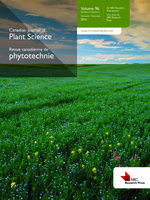Fu, B. X., Hatcher, D. W. and Schlichting, L. 2014. Effects of sprout damage on durum wheat milling and pasta processing quality. Can. J. Plant Sci. 94: 545-553. Due to concerns over the unusual sprouting problem observed in the 2010 harvest of Canada Western Amber Durum Wheat (CWAD), it was deemed necessary by the industry to investigate and determine if appropriate tolerances for sprout damage were in place, particularly for No. 3 CWAD. More information on the impact of visually assessed sprout damage on durum quality is needed to better define the associated acceptable level of falling number (FN). To this end, two different samples of CWAD were sourced for this project: a No. 1 CWAD (FN 479 s) and a No. 5 CWAD (FN 68 s) degraded primarily due to sprout damage. A total of 19 samples were used in the study, i.e., a series of eight composite samples prepared by blending the No. 1 with increasing amounts of No. 5, as well as the two control extremes. The FNs of the blends were well characterized, displaying an incremental decrease of ~50 s with increasing sprout damage. Each wheat sample was milled in duplicate. The resulting semolina was analyzed for ash, pigment, pigment loss, yellowness (b*), and speckiness. Protein content, gluten index and alveograph parameters were also evaluated. The semolina was made into spaghetti for colour measurement and texture evaluation. Results indicated that there was no change in ash content, pigment or semolina b* value even at 50% blend (FN 101 s). However, a noticeable increase in total speck count and the number of dark specks in the semolina were detected once the blending ratio reached the 35% level (FN 208 s). The increase in speck count was largely due to mildew associated with the No. 5 CWAD sample. The influence of sprout damage on gluten strength was minimal at all levels of blending. A significant increase in spaghetti redness (a*) was detected in blends with 25% (FN 152 s) or more of No. 5 CWAD. A decline in spaghetti brightness (L*) was also observed when transitioning from the 15% blend (FN 204 s) and very evident at the 35% blend (FN 123 s) level. No discernible differences due to sprout damage were noticed within the composite blends in terms of processing properties, firmness and cooking loss of the cooked pasta, although spaghetti made from the No. 5 sample showed slight checking, higher cooking loss and lower firmness.
How to translate text using browser tools
3 January 2014
Effects of sprout damage on durum wheat milling and pasta processing quality
B. X. Fu,
D. W. Hatcher,
L. Schlichting
ACCESS THE FULL ARTICLE
It is not available for individual sale.
This article is only available to subscribers.
It is not available for individual sale.
It is not available for individual sale.

Canadian Journal of Plant Science
Vol. 94 • No. 3
March 2014
Vol. 94 • No. 3
March 2014
dommages causés par la germination
Dur
durum
falling number
qualité
quality
sprout damage




